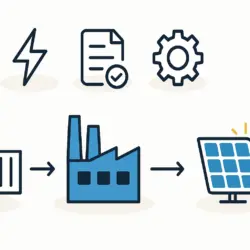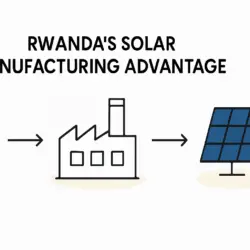Rwanda to Electrify 1,000 Villages with Solar Power
Rwanda is set to electrify over 1,000 villages with solar power, a transformative move announced by the Ministry of Infrastructure on March 11, 2024. This ambitious project, a joint effort between the government and the private sector, highlights the country’s commitment to expanding electricity access, particularly in rural areas. The completion target for this initiative is 2025.
A Key Part of Rwanda’s Energy Access Plan
The electrification project is a central pillar of Rwanda’s Energy Access Rollout Plan (EARP), which aims to improve electricity access nationwide with a strong focus on rural regions. Known for its sustainability and cost-effectiveness, solar power is a cornerstone of this initiative and an ideal solution for remote communities. For more insights into Rwanda’s solar initiatives, you can explore Rwanda Solar Panel Manufacturing | Market Insights Report.
Significant Progress in Electricity Access
Over the past decade, Rwanda has made significant strides in expanding electricity access. While only 10% of the population had access in 2010, that number surged to over 60% by 2024. With a goal of achieving universal access by 2025, solar power has been integral to these efforts.
The government has leveraged the country’s abundant sunlight, using subsidies and incentives to promote solar adoption in rural areas. The electrification of these 1,000 villages is expected to revolutionize residents’ lives by improving living standards, creating economic opportunities, and enhancing education and healthcare.
The Advantages of Solar Power Adoption
As a clean, renewable energy source, solar power avoids the harmful emissions of fossil fuels, making it an environmentally friendly choice for rural electrification. While the initial investment in solar panels can be high, the long-term savings on fuel and maintenance are substantial. Solar panels can also be deployed swiftly, offering a practical solution for villages disconnected from the national grid. Learn more about the potential of solar energy in Rwanda with Rwanda Solar News Archives.
Fueling Economic and Social Transformation
Electrifying 1,000 villages is expected to create significant business opportunities in Rwanda, boosting the economy by enabling small businesses to expand their operations while fostering entrepreneurship and innovation. In the education sector, electricity will allow schools to use modern teaching tools, enhancing students’ learning experiences. Healthcare services will also benefit, as access to power will enable medical facilities to use essential equipment like vaccine refrigerators, improving both quality of care and disease prevention.
Challenges and Future Plans
Despite this notable progress, challenges to achieving universal electricity access remain. The high cost of solar panels and equipment presents a significant barrier for many rural households, a challenge the government is addressing by providing financial support to low-income families. Improving the reliability of the power supply is another key focus. As outages are still common, especially during the rainy season, the government is investing in infrastructure and technology to ensure stability.
This 1,000-village project is part of Rwanda’s broader energy strategy, which includes investments in other renewable sources like hydropower and biomass. This diversification is aimed at reducing reliance on fossil fuels and strengthening the country’s energy security. To stay updated on Rwanda’s solar capacity developments, visit Rwanda solar capacity to Surpass Hydropower by 2025: A Stunning Shift.



